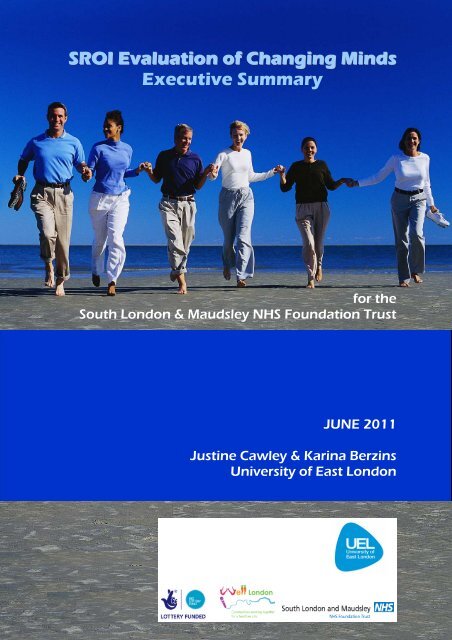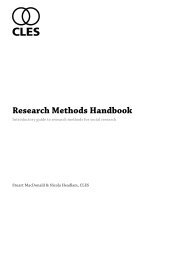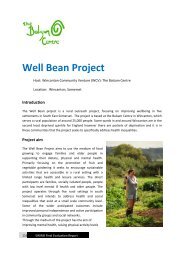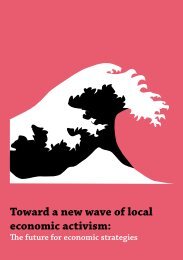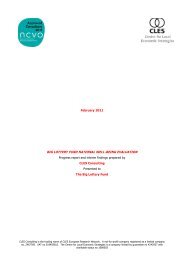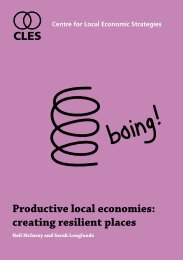Changing Minds programme - CLES
Changing Minds programme - CLES
Changing Minds programme - CLES
Create successful ePaper yourself
Turn your PDF publications into a flip-book with our unique Google optimized e-Paper software.
SROI Evaluation of <strong>Changing</strong> <strong>Minds</strong><br />
Executive Summary<br />
for the<br />
South London & Maudsley NHS Foundation Trust<br />
JUNE 2011<br />
Justine Cawley & Karina Berzins<br />
University of East London
Contents<br />
Headline Findings.................................................................3<br />
Introduction ...........................................................................5<br />
The <strong>Changing</strong> <strong>Minds</strong> Programme - Background............5<br />
The SROI Approach ..............................................................9<br />
Methodology ...................................................................... 11<br />
Impact Mapping ................................................................. 14<br />
Stakeholders..................................................................... 14<br />
Financial Indicators ........................................................... 15<br />
Non Monetised Benefits ................................................... 19<br />
Beneficiaries: Interviews with Participants .................. 20<br />
Conclusion........................................................................... 23<br />
Recommendations............................................................. 24<br />
2
Headline Findings<br />
The Social Return on Investment (SROI) for<br />
the <strong>Changing</strong> <strong>Minds</strong> <strong>programme</strong> is<br />
for every £1 spent £8.78 of<br />
social value is created<br />
This represents a high social return and<br />
good value for money<br />
SIGNIFICANT BENEFITS FROM THE PROJECT WERE:<br />
• Many beneficiaries found employment through doing the<br />
course; many of these are now working as support workers in<br />
the field of mental health.<br />
• Participants talked about the increase in their social networks,<br />
and some talked about improved family relationships.<br />
• Some beneficiaries continued to volunteer after the course had<br />
ended.<br />
• Some beneficiaries used their new-found confidence to pursue<br />
formalised learning outcomes and have improved their<br />
education as a result of the <strong>programme</strong>.<br />
Outcomes indicated that most of these benefits were true of all<br />
graduates, whether they went on to deliver training or not.<br />
3
Beneficiaries also reported a number of positive health related<br />
outcomes, in particular:<br />
• Increased confidence<br />
• Increased mental well-being<br />
• Better physical health<br />
• More physical activity<br />
• Reduction in medications<br />
• Reduced visits to health care professionals<br />
• Sleeping better<br />
• Weight loss<br />
The fact that graduates were interviewed some time after the project<br />
had finished (approx 2 years), demonstrates that there is also a<br />
sustained effect. It shows that this client group in particular benefit<br />
disproportionately from interventions that integrate them back into<br />
society. This was clearly a very successful <strong>programme</strong> for both the<br />
clients and society as a whole, with £8.78 of social value created for<br />
every pound spent.<br />
4
Introduction<br />
The <strong>Changing</strong> <strong>Minds</strong> Programme – Background<br />
<strong>Changing</strong> <strong>Minds</strong> was a project delivered by the South London and<br />
Maudsley NHS Foundation Trust (SLaM). It aimed to develop and<br />
equip participants to design and co-deliver mental health awareness<br />
training courses to challenge stigma and discrimination within staff<br />
groups and in their local communities. People undertook a ninemonth<br />
part-time training course (consisting of 14-19 sessions) to give<br />
them the skills to co-design and co-deliver training from their own<br />
perspective, and to be paid for so doing.<br />
The objectives of the course were to:<br />
• Develop a ‘pool’ of trainers for SLaM to use internally<br />
• Develop individual skills and prospects for participants<br />
• Raise mental health awareness in the community<br />
Once people had completed the training courses, they had the option<br />
of being paid to deliver mental health awareness training to staff<br />
within SLaM, to other organisations and within community settings.<br />
The pool would deliver different types of mental health awareness<br />
training, according to preference and expertise, for example:<br />
substance abuse; self-harm; wellbeing; coping with bi-polar disorders;<br />
and what carers need to know to support people with a mental<br />
illness.<br />
Each <strong>programme</strong> offered 12-16 places. Places were prioritised using<br />
the following criteria:<br />
• Using or had used secondary mental health services<br />
• From black and minority ethnic communities<br />
• Not already engaged in service user involvement on a regular basis<br />
• From areas within the Well London remit<br />
There was an open referral process that was not diagnosis specific.<br />
The course was co-facilitated by service users, ideally two people<br />
working together, who enabled a ‘mirroring process’ for participants.<br />
5
Between 2008 and 2010 SLaM commissioned four courses to be<br />
delivered by outside community organisations. Participants came<br />
from the 20 London boroughs that were part of the Well London<br />
<strong>programme</strong>. The courses were advertised in mental health services,<br />
GP surgeries and community based facilities, such as Citizen Advice<br />
Bureaux, voluntary organisations and libraries. Marketing commenced<br />
around 1-2 months before each course began. An information/taster<br />
day was then held in a non-medical venue for people who had<br />
expressed an interest in taking part, and application forms were<br />
available which gave people two weeks to decide whether to follow<br />
up their interest.<br />
Organisations in each of the 20 Well London boroughs were invited<br />
to tender for the work. Successful organisations had to demonstrate<br />
their ability to design and deliver mental health awareness training,<br />
and to involve people using mental health services in the design and<br />
delivery of the training. Service-user led organisations were<br />
encouraged to apply for the work.<br />
When the course began it ran for three hours every other week. There<br />
were four different training providers running the courses; Shoreditch<br />
Spa, Mind in Tower Hamlets, Community Options and Kensington &<br />
Chelsea Mind. The original course and <strong>programme</strong> was written and<br />
run by the Programme Lead, Stephanie McKinley. The training<br />
providers ran the course following this best practice.<br />
Sessions covered a range of topics, such as aims and objectives, group<br />
dynamics, facilitation skills, presenting information, structuring a<br />
training course, how adults learn, and equal opportunities. Due to the<br />
uniqueness of the client group, specific sessions were included e.g. a<br />
welfare benefits session, to ensure participants would make an<br />
informed choice regarding employment options on completion of the<br />
course and how to use their own personal mental health experience.<br />
In each of the 20 boroughs, additional funding was offered in order to<br />
deliver 12 mental health awareness training sessions using the<br />
graduates from the <strong>Changing</strong> <strong>Minds</strong> <strong>programme</strong>.<br />
6
The course was developed though ongoing monitoring and review.<br />
Careful monitoring of participants’ progress was undertaken during<br />
debriefing sessions and each session was evaluated, with feedback<br />
given at the next session.<br />
Each participant was required to co-design and deliver a selected part<br />
of a training session to the other participants, which was peer<br />
assessed. A follow-up ‘reference’ session was held one month after the<br />
end of the course. This gave participants the opportunity to assess<br />
their skills and development needs, and explore the level of training<br />
delivery they wanted to get involved with. In addition business advice<br />
was given to people who wanted to become self-employed.<br />
Graduates were offered opportunities to co-facilitate the next course,<br />
with the eventual aim of enabling them to run their own <strong>Changing</strong><br />
<strong>Minds</strong> <strong>programme</strong> alongside another graduate.<br />
In addition, the Programme Lead telephoned participants after six<br />
months for a ‘check up’, and thereafter on an annual basis, in order to<br />
record information about their service user involvement activities,<br />
training delivery, further education and employment outcomes.<br />
The evaluation of the course demonstrated that the most significant<br />
impact was in terms of:<br />
• Having a valued role – through going onto voluntary work,<br />
paid employment and training delivery<br />
• Ability to make decisions and choices<br />
• Enhanced self esteem<br />
• Increased confidence<br />
• Development of supportive social networks<br />
• More optimistic outlook<br />
• Challenging discrimination<br />
As a follow-up to the points that were raised in the evaluation, SLaM<br />
asked the University of East London to undertake an SROI evaluation.<br />
They felt the methodology was particularly appropriate for this type<br />
of <strong>programme</strong>, because it provides a more subtle analysis than that<br />
gained from traditional methodology, which finds it hard to record<br />
7
soft outcomes such as enhanced confidence, health gains, self esteem<br />
etc.<br />
For more information about the <strong>Changing</strong> <strong>Minds</strong> Programme please<br />
contact: stephanie.mckinley@slam.nhs.uk<br />
8
The SROI Approach<br />
SROI started in the United States and has been used worldwide for a<br />
number of years. In 2009 ‘A Guide to Social Return on Investment’<br />
was published by the Cabinet Office which has helped to standardise<br />
the application of SROI. Further Government endorsement has come<br />
from the Centre for Social Justice and their publication ‘Outcomes<br />
Based Government 2011’.<br />
SROI is an approach that measures a broader concept of value than is<br />
usually accounted for in cost benefit calculations. It seeks to “reduce<br />
inequality and environmental degradation and improve wellbeing by<br />
incorporating social, environmental and economic costs and<br />
benefits.” 1 SROI frameworks account for change in an organisation, or<br />
to society, by measuring social and economic outcomes, and uses<br />
monetary values to represent these outcomes. Once these monetary<br />
values have been established, a cost:benefit analysis can be<br />
conducted that includes this notion of social value. Finally, a SROI<br />
ratio is produced that shows the social value in pound terms, against<br />
money spent on the project or <strong>programme</strong>.<br />
The SROI approach is based on seven principles:<br />
• Involve stakeholders<br />
• Understand what changes<br />
• Value the things that matter<br />
• Only include what is material<br />
• Do not over-claim<br />
• Be transparent<br />
• Verify the result 2<br />
There are six stages in calculating an SROI, which are as follows: 3<br />
1 Cabinet Office et al A Guide to Social Return on Investment (2009) page 8<br />
2 Ibid pg 9<br />
3 The six stages are taken from the cabinet office report; here we apply these stages to the SLaM<br />
evaluation<br />
9
Establishing scope and identifying key stakeholders. The scope of<br />
the SROI was established in conjunction with SLaM. There have been<br />
33 graduates from the <strong>programme</strong> and they have had a good success<br />
rate in obtaining employment. The evaluators interviewed 15<br />
graduates (approximately 45% of the total cohort). The evaluators<br />
were given a list of 30 graduates from which we selected the<br />
interviewees. We interviewed both people that had delivered<br />
training as a result of the course and those that hadn’t, and ensured a<br />
representative spread of gender and borough.<br />
Mapping outcomes. Through engagement with the stakeholders, we<br />
developed an impact map, or theory of change, which shows the<br />
relationship between inputs, outputs and outcomes. This impact map<br />
considers the social value of changes in the participants’ lifestyles and<br />
wellbeing that were provoked by their engagement with the<br />
<strong>Changing</strong> <strong>Minds</strong> <strong>programme</strong>.<br />
Evidencing outcomes and giving them a value. This stage involved<br />
data collection to establish what outcomes had taken place, and then<br />
assigning monetary value to them. This data collection was based on<br />
in depth interviews with the graduates and the training providers,<br />
along with meetings with SLaM. Particular financial proxies that were<br />
used, along with their source, are outlined later in this report.<br />
Establishing impact. Having collected evidence on outcomes and<br />
monetised those, the aspects of change that would have happened<br />
anyway, or are a result of other factors, are eliminated from<br />
consideration. This is common economic practice and includes notions<br />
of deadweight, attribution, displacement and drop off. These impacts<br />
are calculated via a percentage; deadweight considers what would<br />
have happened anyway, without the activity under investigation.<br />
Displacement considers any activity that the <strong>programme</strong> under<br />
evaluation displaces. Attribution considers any other things that<br />
contributed to the changes that are being mapped, and drop off<br />
considers the outcomes that might lessen over future years.<br />
10
Calculating the SROI. This stage involved adding up all the<br />
monetised outcomes, subtracting any negatives (in this case the cost<br />
of the project to SLaM) and comparing the result to the investment.<br />
Reporting, using and embedding. This last step involved sharing<br />
findings with stakeholders and responding to them, embedding good<br />
outcomes processes and verification of the report.<br />
Methodology<br />
Although the evaluation primarily utilised the SROI approach in<br />
calculating monetised social value for the <strong>programme</strong>, the data<br />
collected from SLaM and the semi-structured, in-depth interviews with<br />
beneficiaries was also used to evaluate the <strong>programme</strong> in terms<br />
outside of the SROI approach. The following methodology was<br />
employed.<br />
1. Establishing scope and identifying key stakeholders<br />
Stakeholder engagement – we established the stakeholder group<br />
to properly address the scope of the SROI approach. This was done<br />
via a number of meetings between the evaluators and SLaM. The<br />
other stakeholders were the beneficiaries themselves, who were<br />
contacted and interviewed. We interviewed 15 participants who<br />
had completed the <strong>Changing</strong> <strong>Minds</strong> <strong>programme</strong>. A list of graduates<br />
was given to the evaluation team, which consisted of people that<br />
SLaM staff had been able to contact. This represented 30 out of 33<br />
graduates. SLaM had not been able to contact 3 of the graduates.<br />
Approximately half had not delivered any training.<br />
2. Mapping outcomes<br />
A desk review of <strong>Changing</strong> <strong>Minds</strong> was conducted. This was done<br />
via an examination of documentary evidence; including participant<br />
numbers, and any other documents associated with the <strong>programme</strong><br />
including an internal evaluation that SLaM had undertaken, and<br />
financial data on running costs.<br />
11
3. Evidencing outcomes and giving them a value<br />
We conducted semi-structured, in-depth telephone interviews with<br />
15 participants. While these interviews were primarily intended to<br />
collect data for the SROI, there was the opportunity to establish a<br />
framework that went beyond the SROI. Thus the combination of<br />
the SROI approach with a number of qualitative indicators, covered<br />
not only the financial value of these <strong>programme</strong>s, but also helped<br />
us to understand other, soft impacts.<br />
The indicators that we were particularly interested in were as<br />
follows:<br />
i. How the <strong>programme</strong> has helped the participant to be well and<br />
how this might have an impact on health inequalities at a local<br />
level<br />
ii. To establish whether the participant has had less contact with<br />
health services, or is taking reduced medication etc after the<br />
<strong>programme</strong>.<br />
iii. Impacts on health literacy<br />
iv. Image of SLaM and Well London, as result of the <strong>programme</strong>.<br />
v. Influences of beneficiaries on others – e.g. partners and<br />
children, to support their healthier lifestyles<br />
Calculating lating value in financial terms We firstly established what<br />
was material to the <strong>programme</strong> based on the interviews, and a desk<br />
review of the <strong>Changing</strong> <strong>Minds</strong> Programme. We then assigned<br />
financial value to the outcomes. A full breakdown of all the proxies<br />
used, including their source and justifications are included later in<br />
this report. We also asked graduates on a scale of 1 to 10 how<br />
much they attributed the change in their lives to the <strong>programme</strong>.<br />
This then relates directly to the attribution figure.<br />
4. Establishing impact<br />
This involved subtracting benefit values that would have occurred<br />
anyway, without the intervention or <strong>programme</strong> taking place. This<br />
was based on the methodology outlined by the HM Treasury in the<br />
Green Book, which is comparable with the SROI approach.<br />
12
5. Calculating ating the SROI<br />
This involved the calculations to establish the final financial figures<br />
for the SROI, and the SROI ratio of the <strong>programme</strong> in its entirety. At<br />
this stage we undertake a sensitivity analysis. A definition of the<br />
headings for this is explained below. The actual sensitivity analysis<br />
relating to <strong>Changing</strong> <strong>Minds</strong> is described in more detail further on<br />
the report.<br />
6. Recommendations<br />
This final phase of the evaluation considered the SROI calculations<br />
as well as the other qualitative indicators outlined above, to enable<br />
the evaluators to make recommendations about the future of<br />
<strong>Changing</strong> <strong>Minds</strong> or similar <strong>programme</strong>s.<br />
13
Impact Mapping<br />
Stakeholders<br />
One of the key stages in any evaluation, but particularly for the SROI<br />
approach, is to clearly establish the main stakeholders. This better<br />
enables an examination of both the costs, and the nature of change<br />
brought about by <strong>Changing</strong> <strong>Minds</strong>. Through the evaluation we found<br />
the main stakeholders to be:<br />
• Beneficiaries - the graduates of the <strong>Changing</strong> <strong>Minds</strong> (and in<br />
some instances their families)<br />
• Training Providers – Community Options, Mind in Tower<br />
Hamlets, Shoreditch Spa and Kensington and Chelsea Mind<br />
• National Government - due to the benefits saved, and increase<br />
in taxes earned through increased employment, reductions in<br />
benefits<br />
• SLaM - as they had a pool of trainers for the Mental Health<br />
Courses<br />
We interviewed 15 out of the 33 graduates on the <strong>programme</strong> (45%<br />
of the total). There were 55 participants in all, but a number dropped<br />
out – the most common reason was because the participants became<br />
unwell or had other commitments. We agreed with SLaM only to<br />
include those who had graduated from the course (whether or not<br />
they had delivered any training themselves). Thus the evaluation is<br />
based on the Social Returns created by those graduates.<br />
For this SROI we defined the beneficiaries as graduates of the<br />
<strong>programme</strong>, not the recipients of the training that the graduates<br />
subsequently delivered to. This “snowballing” effect, which is at the<br />
heart of the project, could have been included in an SROI, with the<br />
effect of further increasing the levels of Social Return. However,<br />
contacting such a wide pool of “second-tier” beneficiaries was out of<br />
the scope of this project.<br />
14
Financial Indicators<br />
From the interview data, we interviewed 15 beneficiaries to map the<br />
most important changes to the <strong>Changing</strong> <strong>Minds</strong> graduates, (and other<br />
stakeholders). This represented around 45% of the cohort. The<br />
graduates we interviewed had been on the <strong>programme</strong> 2-3 years ago<br />
and had sustained the changes that are described below. We<br />
therefore feel confident in the results and if anything we have erred<br />
on the side of caution.<br />
These are outlined in the table below and on pages 16-17.<br />
Participant 1<br />
• Employment<br />
• Increased tax<br />
• Employers and Employees National Insurance Contributions<br />
• Confidence boost<br />
• Out of supported housing<br />
• Reduced visits to GP<br />
• Reduced visits to health professional both psychotherapist and<br />
GP<br />
• Lowered medication<br />
Participant 4<br />
• Confidence boost<br />
Participant 5<br />
• Volunteering<br />
• Confidence boost<br />
• Better sleeping patterns<br />
Participant 7<br />
• Employment<br />
• Reduced visits to health professionals – psychotherapist<br />
• Reduction in medication<br />
• Increased physical activity<br />
• EDCL course (not monetised but still a benefit<br />
15
Participant 8<br />
• Confidence boost<br />
Participant 9<br />
• Employment<br />
• Increased tax<br />
• Employers and Employees National Insurance Contributions<br />
• Increased physical activity<br />
Participant 10<br />
• Volunteering<br />
• Confidence boost<br />
Participant 12<br />
• Volunteering<br />
• Decreased visits to health professionals<br />
• Weight loss<br />
• Increased social networks<br />
Participant 13<br />
• Reduced benefits<br />
• Volunteering<br />
• Confidence boost<br />
• Reduction in medication<br />
• Increase in physical activity<br />
• Better money management<br />
• Certificate in psycho-analytic psychology (not monetised but a<br />
benefit)<br />
Participant 14<br />
• Employment<br />
• Increased tax<br />
• Employers and Employee National Insurance contributions<br />
• Confidence boost<br />
• Decrease in medication<br />
• Increased physical activity<br />
• Increased social networks<br />
16
Participant 15<br />
• Volunteering<br />
• Confidence boost<br />
• Increased physical activity<br />
• CBT training – Diploma in cognitive therapy (not monetised<br />
but a general benefit)<br />
An SROI Impact map was developed to ascertain the financial<br />
indicators used in the evaluation from the interviews. These were<br />
then applied across the whole cohort (n) 33 to give an estimated<br />
value of savings.<br />
Increase in earnings, as participants moved into employment:<br />
estimated value £139,966<br />
Increased taxation receipts, as a result of people moving from<br />
benefits into employment – total taxation including tax, NIC<br />
Employer and Employees:<br />
estimated value £33,700<br />
Reduction in benefits received as beneficiaries moved into<br />
employment or moved off incapacity benefit:<br />
estimated value £19,938<br />
Volunteering hours:<br />
estimated value £28,582<br />
Costs of supported accommodation as beneficiaries moved out<br />
of supported housing:<br />
estimated value £17,333<br />
Less reliance on medication:<br />
estimated value £400<br />
17
Decrease in the contact with health professionals:<br />
estimated value £22,257<br />
Better sleeping patterns:<br />
estimated value £231<br />
Increase in physical activity:<br />
estimated value £1,709<br />
Weight loss:<br />
estimated value £213<br />
Increased confidence and self esteem<br />
estimated value £18,667<br />
Graduates enhancing their social networks<br />
estimated value £489<br />
Better money management<br />
estimated value £145<br />
Costs of the <strong>programme</strong> to SLaM<br />
£74,047<br />
18
Non Monetised Benefits<br />
Training<br />
A number of the graduates had facilitated training sessions, but these<br />
had been paid for by the <strong>programme</strong> and therefore could not be<br />
monetised for this reason. However some of the graduates had<br />
facilitated courses outside the Well London <strong>programme</strong>. Therefore<br />
there is a social benefit here, but for the evaluation it was not<br />
monetised.<br />
Educational outcomes as a result of participation in the<br />
<strong>programme</strong><br />
A number of graduates gained qualifications, however this<br />
information has not been included because the return from gaining a<br />
qualification are normally seen over a longer period of time and thus<br />
we could not give a social return on it.<br />
Benefits of the training given by the graduates to<br />
recipients subsequent to completing the <strong>programme</strong><br />
The participants were trained to give training on dealing with mental<br />
health stigma and although this report was not able to measure the<br />
ripple effect of the training received, it would be expected that there<br />
would be further changes in behaviour that could be measurable.<br />
Research shows that one of the most powerful ways to reduce mental<br />
health stigma is to have direct contact with somebody who has<br />
experienced mental ill health - based on social contact theory;<br />
(Thornicroft, G. (2006) Shunned: Discrimination against people with<br />
mental illness, Oxford: Oxford University Press). One benefit of this<br />
may be that employers will be more likely to consider employing<br />
people with experience of mental health distress and better able to<br />
support employees with specific needs in this area. Reduced stigma<br />
would encourage people to seek help at an earlier stage and thus<br />
reduce the costs associated with mental illness.<br />
19
Beneficiaries:<br />
Interviews with participants<br />
15 interviews were undertaken, with the views taken to be<br />
representative of the cohort of 33 graduates. The comments were<br />
nearly all positive, with typical comments such as:<br />
‘I was not good at mixing with people and the course<br />
gave me confidence and it made it easier to make<br />
friends’<br />
‘I never missed a session’<br />
‘I feel more balanced now’<br />
‘The training changed my outlook on life so much’<br />
‘The lunches were very good’<br />
‘The team work and working with other in a similar<br />
situation was very good’<br />
‘I can now face everyday challenges’<br />
‘I now connect with other people when I meet people’<br />
‘Because I am well now, other things are falling into<br />
place’<br />
‘I am really proud of what I have achieved’<br />
‘I am much more aware of my moods now, and I don’t<br />
let things get me down’<br />
‘I felt accepted by the others’<br />
20
‘It brought me out of myself, now I can talk in front of a<br />
crowd’<br />
‘The social side has made a big difference to me. I joined<br />
a poetry group through someone I met’<br />
There were some negative comments in that some graduates felt that<br />
the course was too slow also that there was not enough follow up<br />
after the course. One graduate felt that he had been brought to a<br />
certain point of wellness but needed more input he felt the structure<br />
hadn’t been there to support this – this sentiment was echoed by a<br />
couple of others. A number of the graduates wanted to retain the<br />
group ethos after the course and to do joint training with the<br />
members of the group that they had trained with – this again was not<br />
something that had happened.<br />
‘It was too slow paced’<br />
‘Out of our group not many went to the follow up<br />
event’<br />
Although the training courses that a number of the graduates<br />
delivered were not part of the SROI analysis, SLAM provided the<br />
evaluators with some quotes from participants of these training<br />
sessions, to illustrate the ripple effect that the original <strong>Changing</strong><br />
<strong>Minds</strong> <strong>programme</strong> had on the wider community. Although this was<br />
out of the scope of the evaluation, it illustrates the potential for<br />
greater economic benefits.<br />
‘Better insight and understanding. Able to see<br />
someone living a ‘normal life’’<br />
‘Because you don’t realise that normal everyday looking<br />
people have experienced such things’<br />
21
‘It made my understanding of mental health real’<br />
‘Gave me hope that people with mental ill health can do<br />
something better than what people think’<br />
22
Conclusion<br />
The SROI analysis has found a high social return on this project – the<br />
fact that these graduates were interviewed some time after the<br />
project had finished demonstrates that there is also a sustained effect.<br />
It shows that this client group in particular benefit disproportionately<br />
from interventions that integrate them back into society. This was<br />
clearly a very successful <strong>programme</strong> for both the clients and society as<br />
a whole, with £8.78 of social value created for every pound spent.<br />
The project had one core aim: to get clients to train as mental health<br />
awareness trainers. However this was a small part of what the project<br />
actually achieved with the graduates – the list of benefits to a number<br />
of the participants speaks for itself.<br />
There were a couple of recommendations that arose from the findings<br />
of the evaluation, which don’t detract from the project but are aimed<br />
to improve it, if it were to run again. The project did not cherry pick its<br />
participants and welcomed everyone who met the basic criteria; this<br />
was both a strength and a weakness. A strength in that the project<br />
was inclusive and was clearly viewed by some of the graduates as a<br />
major catalyst to help them back into society. A weakness in that<br />
some of the participants felt it was too slow and not geared to their<br />
level of wellness. It is difficult to achieve a balance, but more<br />
consideration to some of the clients who were able and wanted to<br />
work at a quicker rate could be considered.<br />
A number of the graduates felt that they had gained a lot from the<br />
project, particularly being with people who had similar experiences,<br />
and the course had helped them support each other. A few said that<br />
they would have really appreciated having a structure that went<br />
beyond the end of the course, so that camaraderie could be<br />
maintained and would further support positive changes they were<br />
making in their life.<br />
23
Recommendations<br />
• More consideration of the needs of the more socially integrated<br />
and confident participants, in order to ensure they don’t find<br />
the course too slow.<br />
• More follow-up of the graduates, after they have graduated – to<br />
set a structure in place so that they can maintain the support of<br />
their fellow graduates.<br />
• A consideration of accrediting the course, so that this can<br />
contribute to more formalised learning outcomes.<br />
24


